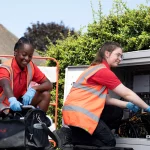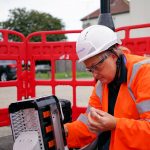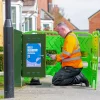ISPA Survey Claims Using Poles for UK Broadband is Less Divisive Than Thought

The UK Internet Service Providers Association (ISPA) has conducted a new Censuswide survey of 2,563 UK respondents to assess public attitude towards using poles for overhead full fibre broadband delivery, which found that 75% of respondents “clearly recognise the benefits of having access to faster and more reliable broadband even if that is delivered via poles.”
Hopefully, by now, most of our readers will already be familiar with the debate around poles, which has become somewhat of a polarising topic. Network operators like poles because they’re quick and cost-effective to build (i.e. allowing their networks to extend into otherwise economically challenging areas), can be deployed in areas where there may be no space or access to safely put new underground cables, are less disruptive (avoiding the noise, access restrictions and damage to pavements of street works) and can be built under Permitted Development (PD) rights with only minimal prior notice.
However, over the past couple of years’ there has been a notable rise in complaints about new poles, particularly from places like East Yorkshire and Greater Manchester. Such gripes typically highlight their negative visual appearance, as well as concerns about exposure to damage from major storms, the lack of effective prior consultation, the duplication of existing infrastructure or engineers that fail to follow safety rules while building etc.
Advertisement
The gripes are often particularly vocal when poles are deployed into areas that have not previously had them. The issue has become such a hot topic that even the UK government has now called on network operators to “limit installation of telegraph poles” when deploying new fibre broadband networks, due to the risk of upsetting communities by “inappropriately or unnecessarily throwing up new infrastructure” (here).
New New Survey
The latest survey, which is admittedly from an industry trade group (vested interest), appears to suggest that the reality of wider public perception around poles may not fit with the often very localised gripes of anti-pole campaigners. For example, it finds that less than 20% of respondents actually ever frequently notice a pole when they are out and about.
Survey Highlights
➤ Three quarters (75%) of British adults surveyed accept having telephone poles in their street if they deliver great broadband.
➤ Almost 7 in 10 (69%) surveyed would accept a new telephone pole in their street today if it delivered better broadband to their house and community.
➤ Less than 1 in 5 (17%) Brits surveyed would not accept a new telephone pole in their street today if it delivered better broadband to their house and community.
➤ Nearly double the amount of respondents rarely or never notice telecoms poles when out and about (37%) compared to only those that frequently or always notice poles when out and about (19%). Just over 2 in 5 (41%) sometimes notice telephone poles when out and about.
➤ Only a small minority (less than 20%) actually ever frequently notice a pole when they are out and about.
➤ Just over 3 in 5 (61%) of those surveyed would not be willing to contribute to paying towards putting poles underground.
➤ Only 3 in 10 (30%) of those surveyed would be willing to contribute towards the added cost of hiding broadband cables underground in their street.
➤ Those who would be willing to contribute to the added cost of hiding broadband cables underground in their street would be willing to contribute, on average, £179 towards the cost of doing so. “The actual cost to hide cables underground in someone’s street would be ten times this per household” (we think the word “could” works better here, since cost does depend and vary based on a lot of different factors).
Steve Leighton, Chair of ISPA, said:
“Upgrading the broadband network to full fibre gigabit broadband is a national priority, one that will deliver significant economic and social benefits across the UK. Poles have always been a historic feature of the UK telecommunications network and the new data clearly shows that the vast majority of the UK population is fine with that.
Our members will avoid erecting new poles but that is not always possible, and in those cases our members try their best to accommodate local concerns, However, the data clearly shows that the public does not want to pay more to hide cables underground.
We will continue to engage proactively with the Government to ensure that local concerns are reflected appropriately but we need to avoid a situation where objections from a minority lead to higher prices for everybody.”
The survey does however miss a trick by seeming to overlook situations where poles are deployed into areas that already have competitive gigabit-capable broadband networks, such as those that are run via underground infrastructure. The focus above seems to be more on locations where poles can deliver “better broadband“, which is naturally an easier argument to make.
At the end of the day, poles remain an important part of helping the UK to build a truly national and competitive gigabit broadband infrastructure, which should be able to reach almost universal coverage by around 2030. As such, the government is currently walking a very thin line, since if they were to clampdown too hard (so far, they haven’t) then the economic models for deploying affordable full fibre networks to such a level begin to fall apart.
Advertisement
Finding the right balance here remains difficult, hence why the government’s recent industry warning was more about firming up existing guidance than implementing any harder restrictions.
Mark is a professional technology writer, IT consultant and computer engineer from Dorset (England), he also founded ISPreview in 1999 and enjoys analysing the latest telecoms and broadband developments. Find me on X (Twitter), Mastodon, Facebook, BlueSky, Threads.net and Linkedin.
« Freedom Fibre Open £25k Community Fund for North Shropshire























































Unsurprisingly the ISPs find that saving them money is a thing they want to do. What’s the point in commissioning such biased studies?
Most people don’t care about how their broadband is delivered. If poles already exist, use them. If poles don’t exist, dig underground or use existing ducting.
Why we can’t do what they do in the US and just have hollow pavements (at least in new-build areas) so underground services can be delivered without digging?
Firstly, its not usually the ISP that is responsible for the infrastructure.
Secondly, there is not always space to add more ducting underground. People seem to think underground is endless, but you have to be mindful of what is already there. Existing ducting may be full or broken so the cost increases dramatically as you need to both replace it while not breaking existing users of that ducting. The ducting may be owns by a competitor which they aren’t allowed to use, blame the government for not mandating EVERYONE offers duct sharing agreements (and ultimately for privatising telecoms to begin with).
It already takes ages to get a return on the investment of rolling out fibre, going underground can be completely uneconomical to a point where its overhead or not worth the cost at all. It would be a completely different argument if this was publicly owned, but its not, they are businesses so have to show it will be profitable in the long run.
Internet providers fund study proving that something that raises their profit margin is good has the same energy as Sadiq Khan funding studies to prove that giving him money is good
How it’s funded is kind of irrelevant – do you think people lied filling in the survey?
Yes. Always follow the money especially if the outcome is confirming the bias of the money. The tobacco industry buying doctors to prove smoking is good in the 50s and 60s is a great example
@Alex.
Yes, undoubtedly, those people who did complete this survey were either ISP staff members, received some kind of remuneration or were a specially selected group based on their demographic (e.g. living in heavily urbanised/run down area, in rental property or student accommodation).
Would the results of this survey have seen the light of day if 75% of respondents said no? I doubt it. If you had no interest in broadband would you have responded at all? Highly unlikely. How many of the regular contributors to this website could say they had no interest in the subject? Absolutely none! I’ve lived where I’ve been served by poles all my life so I don’t really think about them. It’s hard though to take this survey seriously when it’s clearly giving them the result they would have wanted.
Needless mention of Sadiq Khan, presumably with an underlying perjorative intent.
John rarely lets an opportunity, regardless of how tenuous the link is, to complain about Sadiq Khan go to waste.
Not sure why he doesn’t move given he seems to really dislike London and holds the majority of the population in contempt for not voting the way he wants them to.
He wants his city back!
Perhaps it would be more ethical to run an independent survey that is actually sent to random members of the public.
No one has ever demonstrated any evidence that this survey actually exists/existed or the terms under which these questions were asked. There ought to be full disclosure of how this survey was conducted and by whom.
Many campaigners already suspect that, the employees (and their mates) of these ISPs have been the ones answering the questions, much like these ISP companies have deployed their staff to post fake reviews to boost their ratings.
The campaigners are, unsurprisingly, wrong if they see this and automatically think the group answering were ISP employees and their mates. That or ISPA are lying and the research company are corrupt.
It’s a good reminder that we all sit in our silos. Not at all surprising that campaigners think everyone is as vehemently opposed to poles as they are.
https://www.ispa.org.uk/new-polling-data-shows-that-broadband-poles-are-not-as-polarising-as-they-seem/
Polling carried out by Censuswide between 02/02/24 – 26/02/24
2,563 UK Respondents (Weighted Nat Rep 18+)
Be good if ISPA fixed the survey questions link, mind. Plenty of ways to make a survey more flattering without using a non-representative group and that’d help answer some more criticisms.
Very unlikely to be rigged respondents but there will be a reason why the questions aren’t published.
No doubt, but claiming it either doesn’t exist or was rigged makes the campaigners look like zealots and severely undermines their legitimate complaints.
Well, ISPA publishing their take from a poll without publishing the tables to back them up is a gift that the campaigners should be all over.
Agreed. However they probably weren’t the intended audience. They’re in their echo chamber and no way even if this poll were beyond reproach would it change their minds.
Think people are missing the point about profit margins. Poles are often the difference between providing a service or not. You can’t even begin to make back your investment if you can’t afford to provide a service in the first place.
Wouldn’t it be great if we had hollow pavements or put everything underground? Yes.
Wouldn’t it be great if world peace broke out and I married Elle MacPherson? Yes.
A number of people unsurprisingly questioning the bias of such a survey. No matter how flawed the pollsters methodology might have been, it’s probably still more accurate than the letters page of the local newspaper/comments section of a website.
I suspect their analysis of the results differs from the questions they actually asked.
It’s like asking if you’d switch to a greener tariff if given a choice, but not being told it’s cost you more than a normal tariff.
“Just over 3 in 5 (61%) of those surveyed would not be willing to contribute to paying towards putting poles underground.”
I should hope not. Burying the poles isn’t going to achieve anything!
As the saying goes: There are lies, damned lies and statistics.
F*****g Boomers.
What we are now seeing is cables between poles, often more than 1.
The key issue is why there should be more then 1 pole in a particular location, pole sharing needs to be compulsory.
Cables between poles isn’t new. More than one is likely to be copper that was there before and fibre. If there are multiple fibre cables going to the same pole infrastructure is being shared: happy days.
Some proper tinfoil hat wearing going on in the comments. Just because a survey is funded by ISPA doesn’t mean the results aren’t representative – companies like Censuswide exist to run arms-length surveys. Is it really so difficult to accept that people don’t care about poles that you’d rather assume the respondents were all friends and family of the ISPs?
Sure, if the survey results hadn’t gone the way ISPA wanted then they probably wouldn’t have published, but that doesn’t alter the fact that the respondents clearly aren’t bothered about poles.
“Tinfoil hat is when people do not want ugly street furniture in front of their houses”
@Sam But people also complain at the mess and disruption digging up the pavement causes. Some people will just moan regardless, and then moan their broadband sucks or is too expensive.
My favourite are people who say it will reduce their property value, when the evidence is the opposite that property in areas with good broadband are worth considerably more.
I find cars lining the streets far more ugly and disruptive than poles, funny how nobody is calling on cars being banned.
NIMBYs moan about everything.
Can you go and moan in your own back garden please?
^^ Case in point ^^
WE ARE THE SILENT MAJORITY AND WE OPPOSE POLES OF EVERY KIND, WE SHOUT FOR EVERYONE AND WON’T BE TOLD OTHERWISE!!!
How do you know you are in the majority? Especially if you are silent?
And how do you shout *and* remain silent?
@binary:
The so-called silent majority are in reality a very SHOUTY minority, which I believe is the OP’s point.
In 5he deeds of our home it states ‘no poles’ in 9ur area that was the contact agreement we bought our home under.That was 45 years ago.we dont want ugly dangerous poles.No one in residential area we l8ve in does.MS3 dont givd flying f go roughshod over us the publ8c.even tho7gh kcom agreed to share infrastructire they could put it under the ground in our utilitiez area front of proerties.we paid to l8ve here oles will put off buyers and reduce house prices
Your deeds cannot decide what happens nearby, they don’t govern either the street once adopted by the local authority or neighbouring ones. That clause is meaningless besides at the moment you moved in. If it promised no poles ever that was nonsense.
KCom’s infrastructure sharing was clearly on terms so bad it was cheaper for companies to build their own. There are 1/10th the new poles once you leave KCom areas. Including from the same companies building them there.
There are millions of poles in the ground providing telephony, Internet and electricity. If they were all dangerous they wouldn’t be there.
People on your group are also moaning about infrastructure going underground and pointing with contempt at pavements with scars on them from streetworks claiming they look third world.
Can’t use poles, digging underground makes things look third world.
‘we paid to l8ve here oles will put off buyers and reduce house prices’
You probably paid about 7/6d for the place. I doubt poles will leave you out of pocket if you sell.
If that’s what it’s all about you also have no argument. A possible drop in house prices is not a legitimate objection to ANY planning application.
At the end of the day if MS3 have upset the residents that much then they it will be that much harder to sell the service to the residents and they will lose money on the deal. Time will tell.
Seems some of the residents are on the brink of getting torches and pitchforks out whenever someone subscribes to a service on the MS3 network which is a bit alarming.
I’ve seen people asking others to name and shame when they’ve seen people subscribed to MS3 and/or publicising the service.
I’ve also seen at least one person who was in their Facebook group giving out information in a neutral manner get booted for not being on message by the looks, which isn’t great. I didn’t see anything written that was wrong but the admin took exception to the dissent.
There seems a bizarre fondness for KCom: challenging the view that they’re great, massive Australian conglomerate investors are well known for dedication to the customers of the businesses they invest in, see Thames Water, and it’s all the evil altnets didn’t go down well.
Local outrage and willful ignorance isn’t a great basis to try and influence national policy. I see a new petition in there to abolish Ofcom as they didn’t give the campaigners the answers they wanted.
The stats remind me of surveys about making improvements for cycling and walking – the majority of people say they support them, but a vocal minority then stir up trouble and block improvements.
Only the industry geeks care about this garbage.
Get yourself a life.
^^ Another very angry NIMBY ^^
The new telegraph poles do appear to be causing a lot of problems in some areas although if you look at the online protest petition only around 1% average of each MP Constituency have expressed concern
https://petitionmap.unboxedconsulting.com/?petition=647970
Look at the map, zoom into Hull and figures appear at the top left
In the most active Beverley and Holderness constituency the conservative MP has about 1.89% unhappy, in the Labour MP’s Hull constituency 0.3%
The petition does show that only a very small minority are concerned.
Most people seek a choice of FTTP provider at an affordable price
What lies you spew, need it for video games do you?
You sad pleb!
^^ Someone’s gotten very hot under the collar! ^^
This with the petition author spamming it so hard across so many groups on Facebook she was suspended for a time.
I have a lot of sympathy but they’ve gotten a little radicalised and that’s lost me. The willful ignorance of the main cause in those constituencies for the proliferation of poles is also frustrating.
A couple of other areas where some truly dire stuff has happened too, however that doesn’t mean changing the rules nationally completely back the other way.
We’ve an awful lot of issues from people demanding ‘a say’.
The parasites who run this web page will publish any lies for cash.
Nobody wants this crap.
What a balanced and well argued point. Congratulations!
Do you not think you’re maybe a little radicalised when you come out with stuff like this?
No-one wants them, they aren’t lining up to have a pole stuck outside, they may tolerate them in return for some benefit.
Yes, a well known survey and public relations technique . . . the Albright/OFCOM method . . . . tell the public that you are against it, whilst simultaneously giving the wink and nod green light to the perpetrator.
Always works out well.
The question is, how well does a flown fibre cable stand-up to the weight of an old pair of trainers laced together and catapulted over the line (Not uncommon in my area) – they’ll dump rubbish anywhere nowadays.
Actually better than copper, the fibre cables are reinforced with Kevlar. My brother-in-law used to work for Openreach and at one of their test sites they had a cable setup between 2 poles and put downward tension in the middle and it was bending the poles without breaking the cable.
If you’ve poles already for phone service this is also how you’ll get fibre.
Virgin Media would’ve been an option but I believe you prevented them from serving at least part of the area?
Virgin and BT have conduits in the public street – I aimed to prevent the Virgin installers digging-up the pavement to the unadopted service road that abutts my property because, firstly, they didn’t have way-leave from the landlord of the private estate and secondly, BT conduit already existed under that pavement and my belief was that the Telcommunications Act 1984 required them to use existing conduit first before considering other work . . makes economic sense I objected again when they tried to install a telegraph pole on the private estate to fly the cable on to the estate . .again without way-leave and again when the possibility of utilising existing conduited hadn’t even been considered.
Install management, lazy as fluff.
But there you go, cowboys in 1990, ditto today.
My connection to BT (1985 built house) is underground, whilst the rest of the 1930s built street is via poles. And should I take up a connection with Virgin (If hell should freeze-over) then that would be underground.
So most of the developments in the 1980s and 1990s could afford to install underground. And 36 years later, at a UK long-term average economic growth rate of 2% per year elapsed since then, the economy is twice the size today it was then. If it could be afforded then, why not now ? Especially when the techniques for underground installation have been refined and costs lowered.
Logic doesn’t apply when greed is the name of the game and regulation non-existent.
80s/90s BT retained a monopoly. Costs for services were astronomical relative to now.
The cable companies couldn’t afford to go underground, hence both ntl and Telewest going into bankruptcy protection.
GDP irrelevant to this, it’s private companies doing the work. We can’t afford the basics as a country at the moment let alone subsidising underground telecoms builds. Ageing population that don’t want to pay their way. Tax system messed up as loads of untaxed, unearned wealth, lower proportion of taxable income. Very high housing costs draining disposable incomes.
Tricky to reconcile their trying to build a pole at that time given they were out and out banned anywhere bar on private property, and they would need wayleave to build on private property.
That and none of the cable companies used a single pole during any of their construction anywhere and had exactly zero hoists or other facilities to work on them. I do vaguely remember you referring to your stopping a scout hut on the grounds of a church getting a phone line via a new pole, and recall you mentioning a long way after that the cable company trying to fly coax along a pole. If they actually tried that that was the only pole any cable company tried to build: there are exactly none anywhere in the UK. The only poles on the VM network were built by Openreach/BT or Sky as part of a trial and carry no coax only fibre.
You were right about the existing infrastructure, though it didn’t apply here else they’d have used it elsewhere as well. There was no mechanism to use BT ducting at that time and to this day no third party can put coax in it to serve residential properties. The only exception is where BT themselves got into the cable game.
This page is an Echo chamber, permitted development rights were never intended for slightly better broadband.
There was Bedlam in my town that they were digging up the pavements, as always there were left in a worse state than they were found.
With these poles I am not surprised there are assaults on the people installing them.
Meanwhile the campaigner pages aren’t?
Briefly coming back to this the permitted development rights were explicitly changed to allow for ‘slightly better broadband’.
So you don’t want them building overground, you don’t want them building underground. Reads like you simply don’t want them to build anything anywhere and describe as an echo chamber anything that doesn’t agree with your world view.
This is ISPReview. It can’t be that surprising that there are some folks here that aren’t bothered by poles. There are also some, like me, that are in the middle and some that agree with you. For an echo chamber it seems pretty discordant.
The BBC comedy “Yes Minister” explains how you conduct an opinion poll to get get the result you want. Here:-
https://youtu.be/6GSKwf4AIlI?t=74
If more residents of an area are opposed to poles than not, and underground cables are not possible or viable, then no FTTP for them ig. I don’t much like poles, but no sacrifice, no victory. I can certainly see those opposed to poles also be opposed to pavement or land scaring, how ugly.
Recently Freedom Fibre decided to install poles all the way down a number of streets that have always been fed DPA by Openreach, none of the residents are the slightest bit impressed, indeed a vast majority of the properties have wooden fascia across the upper half so quite where they plan to install eyebolts I don’t quite now.
In another area they installed poles to daily chain down a road rather than dig it up and install the network properly, all it takes is for the 1 span to be taken down and an entire neighbourhood will lost their internet (should anyone take the FF supplied packages).
Then down yet another you can see the daisy chain going straight over the Openreach cables already in place to the point its actually resting on the top of the Openreach network in the air, so much for not crossing lines when installing OH fibre.
Poles are simply being installed as the utter cheapest way to install a network and to date every FF pole installed has zero connections coming from them despite the flyers being dropped stating the neighbour hoods are now FF enabled, see more Virgin media and BT/OR vans doing installs.